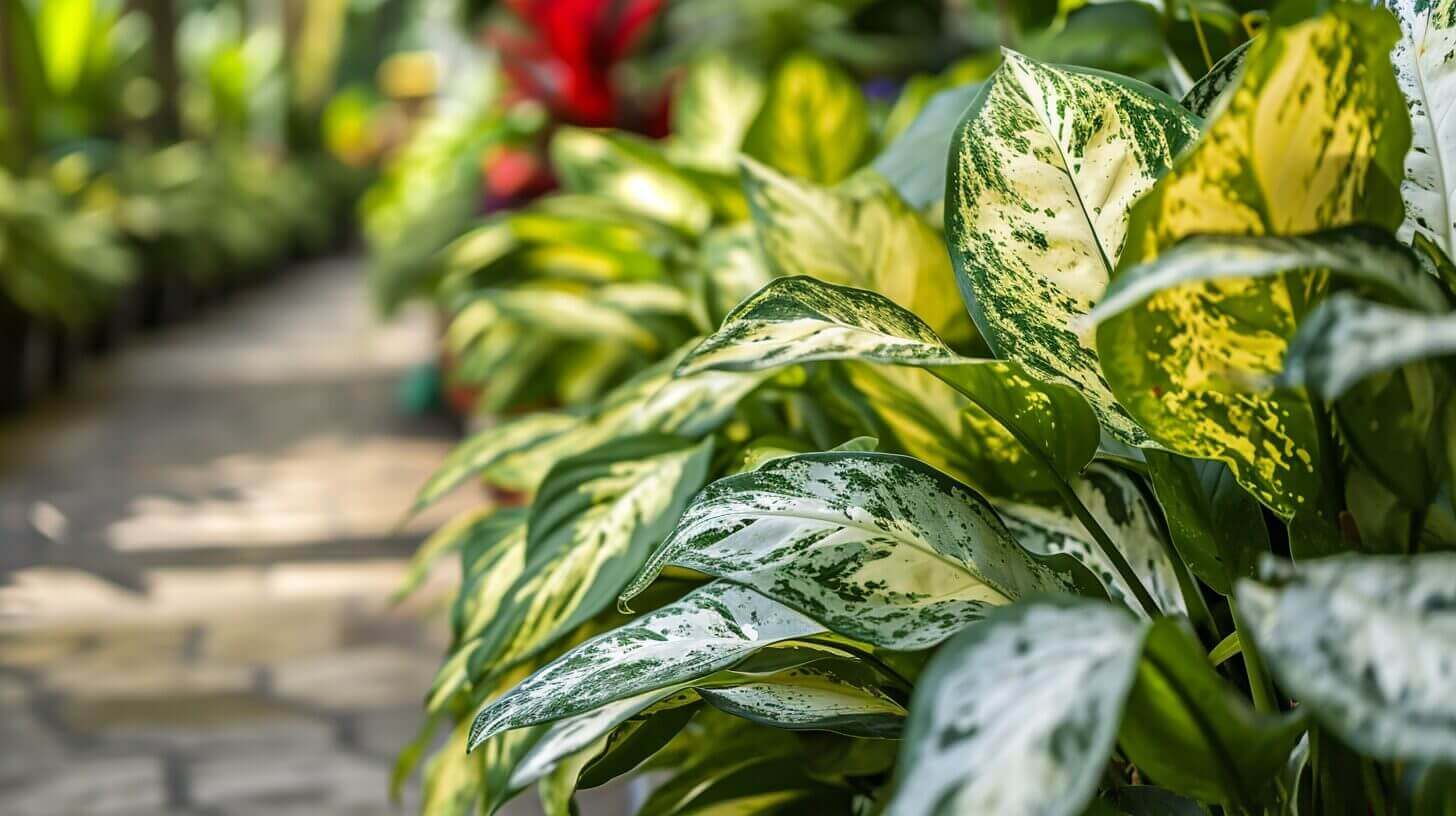Did you know that Chinese Evergreen (Aglaonema) is one of the most popular indoor plants worldwide, known for its ability to thrive in low-light conditions?
However, just like any other plant, it requires the right amount of sunlight to maintain its health and beauty.
In this article, we will explore the light requirements of Chinese Evergreen and discuss whether it can get too much sun. By understanding its needs, you can ensure the optimal environment for this beloved plant to flourish.
Key Takeaways
- Chinese Evergreen thrives in bright, indirect sunlight
- Ideally, 4-6 hours of indirect sunlight per day is recommended
- Excessive sunlight can lead to leaf burn and damage
- To protect the plant from excessive sun, provide shade during the hottest parts of the day and use sheer curtains or blinds to filter sunlight
Optimal Sunlight Exposure for Chinese Evergreen
The optimal sunlight exposure for the Chinese Evergreen houseplant depends on its specific cultivar and its growth stage. Different varieties of Chinese Evergreen have varying levels of sunlight tolerance. Some varieties can tolerate direct sunlight, while others prefer indirect or filtered sunlight. Understanding the sunlight needs of Chinese Evergreen is crucial for its growth and health.
Sunlight plays a vital role in the photosynthesis process, which is essential for the plant’s energy production. Adequate sunlight exposure helps the Chinese Evergreen to maintain its vibrant green color and promote healthy leaf growth. However, excessive sunlight can lead to leaf burn and damage. It is important to strike a balance and provide the Chinese Evergreen with the right amount of sunlight to ensure its optimal growth and overall well-being.
Understanding the Sunlight Needs of Chinese Evergreen
To effectively meet the sunlight needs of Chinese Evergreen, it is important to consider factors such as intensity, duration, and timing of sun exposure.
Chinese Evergreen plants thrive in bright, indirect sunlight. They prefer moderate to low light conditions, making them suitable for indoor environments.
When it comes to sunlight duration, Chinese Evergreen can tolerate a wide range of exposure. Ideally, they should receive about 4-6 hours of indirect sunlight per day. However, they can also adapt to lower light conditions and survive with as little as 2 hours of sunlight.
For those who cannot provide enough sunlight, indoor lighting alternatives can be used. LED grow lights or fluorescent lights with a full spectrum can mimic natural sunlight and provide the necessary light for the Chinese Evergreen to thrive.
These options ensure that the plants receive the required light intensity and duration, even in indoor settings.
Signs of Overexposure to Sunlight in Chinese Evergreen
Excessive exposure to sunlight can result in detrimental effects on the health and appearance of Chinese Evergreen plants. One of the most common signs of overexposure to sunlight is sunburn. The leaves of the Chinese Evergreen may turn yellow or brown, and in severe cases, they may develop brown spots or wither. Additionally, the plant may show signs of wilting or drooping.
If you notice any of these symptoms, it is important to take action to protect your Chinese Evergreen from further damage. One option is to relocate the plant to a spot with less direct sunlight. When moving the plant, be sure to acclimate it gradually to the new location by exposing it to increasing amounts of sunlight over a period of a few weeks.
By taking these steps, you can help your Chinese Evergreen recover and thrive.
Now, let’s explore how to protect Chinese Evergreen from excessive sun.
How to Protect Chinese Evergreen From Excessive Sun
One effective way to protect Chinese Evergreen from excessive sun is by providing shade for the plant during the hottest parts of the day. Chinese Evergreen is a tropical plant that thrives in indirect, filtered light, and too much direct sunlight can lead to sunburn and damage its leaves.
To shield the plant from the harsh rays of the sun, you can place it in an area with partial shade or use sheer curtains or blinds to filter the sunlight. Another option is to move the plant to a location where it is shielded by other taller plants or trees. By providing shade for Chinese Evergreen, you can prevent sunburn and ensure the health and vitality of the plant.
Now, let’s explore some tips for finding the right balance of sunlight for Chinese Evergreen.
Finding the Right Balance: Sunlight Tips for Chinese Evergreen
Finding the optimal amount of sunlight for Chinese Evergreen is crucial for maintaining its health and growth. Sunlight duration and positioning play a significant role in determining the well-being of this plant. Here are some important tips to help you find the right balance:
- Indirect sunlight: Chinese Evergreen thrives in bright, indirect sunlight. Place it near a window with a sheer curtain or in a well-lit room.
- Avoid direct sunlight: Direct sunlight can scorch the leaves of Chinese Evergreen. Position it away from windows that receive intense sunlight during the day.
- Rotate the plant: To ensure even growth, rotate the plant every few weeks. This allows all sides of the plant to receive equal sunlight.
- Monitor light levels: Use a light meter to measure the amount of light your Chinese Evergreen receives. Aim for a range of 1500 to 2500 foot-candles for optimal growth.
- Observe the leaves: Pay attention to the color and health of the leaves. If they start turning yellow or pale, it may indicate that the plant is receiving too much or too little sunlight.
Frequently Asked Questions
Can Chinese Evergreen Survive in Low Light Conditions?
Chinese evergreen, known for its shade tolerance, can survive in low light conditions. To ensure its growth in dimly lit areas, it is important to provide indirect, filtered light.
Placing the plant near a north-facing window or using artificial grow lights can help maintain its health. Additionally, avoid exposing it to direct sunlight, as it can lead to leaf burn.
With proper care and attention to its light requirements, Chinese evergreen can thrive in a variety of lighting conditions.
Is It Possible to Overwater Chinese Evergreen?
Overwatering can have detrimental effects on Chinese Evergreen plants. It is important to understand the best watering practices to ensure their health and longevity. Excessive watering can lead to root rot, which can cause the plant to wilt, develop yellow leaves, or even die.
To avoid overwatering, it is crucial to allow the top inch of soil to dry out before watering again. Additionally, using well-draining soil and pots with drainage holes can help prevent waterlogged conditions.
What Are the Signs of Underwatering Chinese Evergreen?
Signs of underwatering Chinese evergreen include wilting, yellowing or browning leaves, and dry soil.
To properly care for Chinese evergreen, it is important to ensure that the plant receives adequate water, but not in excess. Water the plant when the top inch of soil feels dry. Avoid overwatering, as this can lead to root rot.
Additionally, Chinese evergreen prefers bright, indirect light, but can tolerate lower light conditions.
Can Chinese Evergreen Tolerate Extreme Temperature Fluctuations?
Chinese evergreen, known for its resilience and beauty, is sensitive to extreme temperature fluctuations. This tropical plant prefers temperatures between 65-75°F (18-24°C) and can suffer if exposed to temperatures below 60°F (15°C) or above 85°F (29°C).
Drastic changes in temperature can cause wilting, leaf damage, and even death.
To ensure the survival of your Chinese evergreen, it is crucial to provide a stable and moderate temperature environment.
How Often Should I Fertilize Chinese Evergreen?
When it comes to fertilizing Chinese Evergreen, it is important to consider the best fertilizer and the frequency of application.
Chinese Evergreen plants benefit from regular fertilizing to ensure optimal growth and health. It is recommended to use a balanced, water-soluble fertilizer with a ratio of 10-10-10 or similar.
As for the frequency, fertilizing every two to four weeks during the growing season is ideal. This will provide the necessary nutrients for the plant to thrive.







